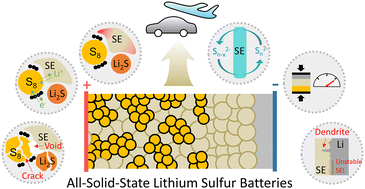Bridging the gap between academic research and industrial development in advanced all-solid-state lithium–sulfur batteries
Abstract
The energy storage and vehicle industries are heavily investing in advancing all-solid-state batteries to overcome critical limitations in existing liquid electrolyte-based lithium-ion batteries, specifically focusing on mitigating fire hazards and improving energy density. All-solid-state lithium–sulfur batteries (ASSLSBs), featuring earth-abundant sulfur cathodes, high-capacity metallic lithium anodes, and non-flammable solid electrolytes, hold significant promise. Despite these appealing advantages, persistent challenges like sluggish sulfur redox kinetics, lithium metal failure, solid electrolyte degradation, and manufacturing complexities hinder their practical use. To facilitate the transition of these technologies to an industrial scale, bridging the gap between fundamental scientific research and applied R&D activities is crucial. Our review will address the inherent challenges in cell chemistries within ASSLSBs, explore advanced characterization techniques, and delve into innovative cell structure designs. Furthermore, we will provide an overview of the recent trends in R&D and investment activities from both academia and industry. Building on the fundamental understandings and significant progress that has been made thus far, our objective is to motivate the battery community to advance ASSLSBs in a practical direction and propel the industrialized process.



 Please wait while we load your content...
Please wait while we load your content...